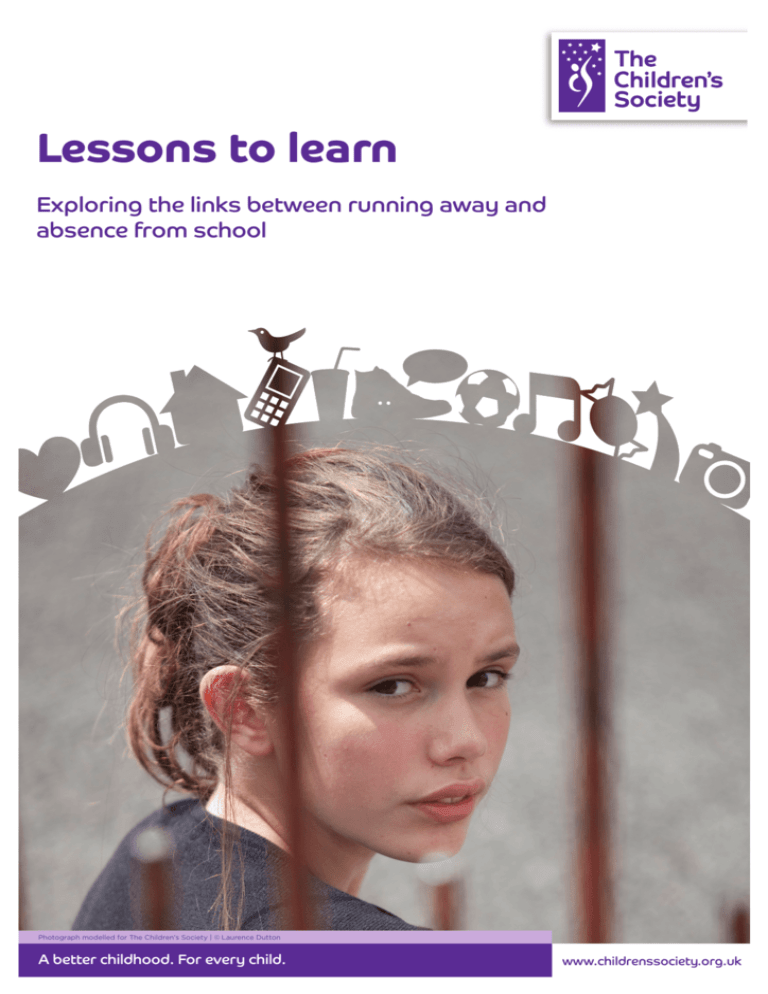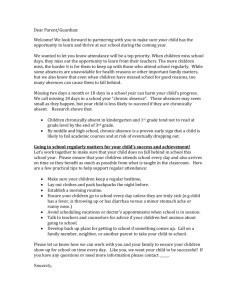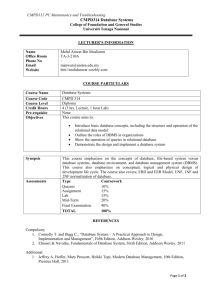Lessons to learn - The Children's Society
advertisement

Lessons to learn Exploring the links between running away and absence from school Photograph modelled for The Children's Society | © Laurence Dutton A better childhood. For every child. www.childrenssociety.org.uk We would like to thank Gwyther Rees, Emilie Smeaton, Becky Hug and Zeina Whalley for their contribution to the research for this report. Thanks also to Iryna Pona and Ellen Broome for very helpful comments on drafts and Marsha Lowe for editing. Most importantly, thanks to the practitioners from our services and young people who were interviewed and shared their experiences with us. This report was written by Natalie Williams. For further information on this report, please contact: Natalie Williams, Policy officer Iryna Pona, Policy advisor The Children's Society Edward Rudolf House Margery Street London WC1X 0JL Email: policy@childrenssociety.org.uk Follow us on Twitter @childsocpol Summary ‘It’s not about running away; it’s about all the problems young people face. Missing from home and missing from education is a symptom, not a problem in isolation.’ Practitioner, The Children’s Society. Introduction Every year, 100,000 children run away from home or care in the UK. 1 They often run from serious problems at home such as family breakdown, abuse, neglect or problems at school such as bullying or unmet special educational needs. When children run away they are at risk of physical abuse, sexual exploitation or being forced to resort to highly dangerous survival strategies such as stealing or begging to survive. 2 Our research shows that children who run away are three times more likely to be absent from school. 3 Children spend more time at school than anywhere else. It is crucial that school and education professionals are able to recognise running away as a cry for help. This report explores the link between problems at school, including absences and exclusions, and running away. It makes a series of recommendations about how young people at risk should be supported and how professionals can better meet their needs. Key messages • Children who are absent from school are more than three times as likely to have run away. • Young people usually run away because of problems at home or school. Others may run away because they are being sexually exploited or become involved in crime. • Schools professionals need to have a better understanding of the risks faced by children when they run away and the warning signs that they may be running away. • Schools and local authorities must ensure that absences are correctly recorded and analyse data for patterns of running away. • Schools should ensure they initiate an assessment of need when a young person is running away or is persistently absent from school. • Schools need to have access to multi-agency teams that can intervene early and provide holistic support to young people who run away and their parents. 1 Rees, G (2011) Still Running 3: Early findings from our third national survey of young runaways, 2011 London: The Children’s Society 2 Ibid 3 ‘Absent’ children are those who are registered at a school but who are not attending regularly. Their absence can be authorised or unauthorised by the school. Parents/carers may or may not be aware of their children’s absences and the school should inform them whenever a pupil is absent. Persistent absence is defined as missing 15% of school time - equivalent to 38 half days DfE (2012) School attendance guidance http://www.education.gov.uk/schools/pupilsupport/behaviour/attendance [accessed 22/11/12] 2 1. The links between running away and absence at school The number of children absent from secondary school is very high. Nearly 200,000 secondary school children missed a month of school last year. 4 Around 40% of these absences were unauthorised. 5 On average these children are missing one day a fortnight of school due to unauthorised absence. Our research has found that children who are absent from school are more than three times as likely to have run away. 6 ‘I don’t often find young people who are running who are not absent from school.’ Practitioner, The Children’s Society. Figure 1: Children who have run away overnight and have problems with school attendance and exclusion 7 Children who run away may miss parts or all of the school day. Our practitioners also find that the young runaways they work with are more likely to have unauthorised absences from school. This practitioner explains a common pattern: ‘The young people we are working with aren’t running away for weeks at a time, they’re staying out on a Friday night and not coming home till Monday evening or staying out on a Tuesday night and that might mean they are missing school on the Wednesday because they are too tired.’ Practitioner, The Children’s Society. Common reasons why young people run away Running away is often a cry for help. It is a sign that a young person is experiencing deeper, underlying problems at home or at school. Young people who run away are more likely to have poor relationships with their family. Many have 4 DfE (2012) Pupil Absence in schools in England: Autumn Term 2011 and Spring Term 2012 Ibid 6 Rees, G (2011) Still Running 3: Early findings from our third national survey of young runaways, 2011 London: The Children’s Society 7 Rees, G. and Lee, J. (2005) Still Running II: Findings from the second national survey of young runaways London: The Children’s Society 5 3 learning difficulties, mental health problems or are misusing drugs or alcohol. Often they run away because their home life becomes unbearable or their parents are unable, or unwilling, to care for them. ‘It snowballs, so at the start the problem could just be school but then everything else starts to fall apart for them as well.’ Practitioner, The Children’s Society. Children who run away are also more likely to be unhappy at school, which leads to them running away during the school day. Figure 2: Average well-being scores for young runaways 8 Young people who have run away are more likely to feel they are not doing well at school. They have lower educational aspirations, are less likely to engage in post16 education or go to university. 9 Young people who had been excluded from school are almost three times as likely to have run away. 10 ‘I never liked school. The work we were supposed to do didn’t make sense to me. I used to feel like I was stupid and some of the other kids used to tease me for being thick. I was always getting into trouble for fighting them. But I got into this gang because of it and we started missing school. My mum got really mad. That’s when I started to run away and was excluded from school.’ Troy 11 , a young person. 8 Rees, G (2011) Still Running 3: Early findings from our third national survey of young runaways, 2011 London: The Children’s Society 9 Ibid 10 Rees, G. and Lee, J. (2005) Still Running II: Findings from the second national survey of young runaways London: The Children’s Society 11 Not his real name 4 Unhappiness at school, or home, is often displayed through challenging behaviour in school. It is therefore vital that schools staff always investigate why a child is behaving in such a way, as this could be a sign that they are running away or may do so in the future. ‘There are a lot of behavioural issues. Often the behavioural issues displayed in schools reflect what’s happening to them outside of school, family circumstances etc which is often a large reason for their missing episodes.’ Practitioner, The Children’s Society. 5 2. Recognising the risks and indicators of running away Schools professionals need to be aware that any unauthorised absence from school may be an early warning sign of running away and act immediately. Failure to do so leaves vulnerable children at risk of further harm or exploitation. Absence from education may also be a sign that a child is running away to things that put them in danger. These ‘pull’ factors may be substance misuse, criminal activity or sexual exploitation where children are pressured by peers or predatory adults who exploit their vulnerability. Recent high profile and widely publicised sexual exploitation cases in different parts of the country illustrate this all too well. Indeed the Office of the Children’s Commissioner’s inquiry found that 65% of the sexually exploited children who were interviewed were not attending school. 12 When young people run away, they face many serious risks on the street. One in four children has at least one harmful or risky experience such as begging, stealing and sexual exploitation while away from home. 13 In many cases running away will be a combination of these ‘pull’ factors and ‘push’ factors, such as problems at home or school, as the case study below shows. Case study 1: Lula* Lula was having problems at home which caused her to miss school and start running away: ‘I had to look after my younger brothers ‘cos me mum and stepdad weren’t in any fit state to look after them… I used to miss loads of school… Sometimes teachers would ask why I wasn’t at school but some of them realised what me mum and stepdad were like and I think they kind of gave up on me.’ She found herself getting involved in a dangerous situation and dropped out of school altogether: ‘I started to run away ‘cos of everything going on at home and being fed up of being the one who looked after me brothers… I met these other kids who were older than me and stayed with them. That’s when I started taking drugs and drinking loads. I stayed away for the whole summer holidays and didn’t go back to school at all … I should have been back at school for my final year to do me GCSEs.’ Lula regrets missing so much school: ‘I wish I’d gone to school more. I’d like to have qualifications and that and be able to get a good job… I also missed out on having mates of me own age and just doing what girls my age do.’ *Not her real name The links between absence from school, running away and the risks faced by young runaways are rarely picked up at an early stage, and often not identified at all. It is crucial that all absences from school are treated as an early warning signal that a 12 Office of the Children’s Commissioner (2012) I thought I was the only one in the word, The Office of the Children’s Commissioner’s Inquiry into Child Sexual Exploitation In Gangs and Groups Interim Report London: Office of the Children’s Commissioner 13 Rees, G (2011) Still Running 3: Early findings from our third national survey of young runaways, 2011 London: The Children’s Society 6 child needs help and support. Professionals need to be equipped to identify these signals. The Department for Education (DfE) guidance states that running away and absence are likely to be signs of underlying problems and that schools should identify and address these issues. 14 Our practitioners report that schools staff often fail to spot the signs when a young person is running away but still attending school – such as tiredness, lateness, dirty clothes, being hungry or displaying challenging behaviour. In particular, there is limited awareness of the signs that a young person may be being sexually exploited, such as text messages or older boyfriends. Case study 2: Shelly* Shelly’s life changed when her mum’s new boyfriend started abusing her. She decided to run away and spent six weeks staying with friends or in the park. One night she was so frightened of men who were drinking in the park that she hid in a bush. Shelly started to miss school. When she did attend, she was tired, hungry and dirty and often told off by teachers for not paying attention and dozing in class. Shelly did wonder why none of the teachers noticed the change in her at school: ‘I went from being a hard-working well-behaved pupil who never got told off to one who was a mess and always being pulled up for something. I mean, did they [school staff] never wonder why I was so different?’ *Not her real name This lack of awareness amongst schools professionals is made worse by a poor understanding of the complex reasons why young people run away. Our practitioners report that many teachers see young people who run away or are absent from school as ‘troublesome’. Several of our projects run one or two day training courses for local authority and schools professionals. These help professionals to identify the indicators of ‘hidden missing’, understand why young people run away and raise awareness of the risks they face on the streets. They also train professionals on how best to support young runaways. Some projects ensure there is a named individual in the schools they work with to enable easy referrals and immediate support for young people. Case study: The Children’s Society, Salford Thirteen young people from our Salford project who have previously run away have created a peer-to-peer DVD which they use to help educate young people, local authority, local safeguarding children boards and schools professionals about the risks of running away. It contains young people’s stories of why they ran away and what happened to them while they were away. The resource includes information on where to go for help and how to support young people. 14 DfE (2009) Statutory guidance (Revised) for local authorities in England to identify children not receiving a suitable education 7 3. Recording and monitoring absences Repeated absences from school are a strong sign that a young person may be running away. Therefore, it is important that all absences are recorded correctly and that schools have appropriate processes in place to identify patterns of running away. Schools (including academies and free schools) are required to notify local authorities of every pupil who has been continuously absent (unauthorised) for 10 school days or more or who fails to attend regularly. 15 It is good practice for schools to inform the local authority of patterns of absence when they have concerns about a child’s well-being, whether the absence is authorised or unauthorised. 16 Part of education welfare officers’ (EWOs) roles is to identify absence trends and make sure that maintained schools (not academies and free schools) have the correct systems in place. 17 However, there have been huge cuts to education welfare teams within local authorities. An Association of Welfare Managers (AEWM) survey of spending cuts affecting its members found that there were planned staff cuts in 28 out of 49 authorities. Thirteen local authorities planned to cut between 50% and 100% of staff. 18 ‘Education welfare officers (EWOs) are largely a dying breed, as they are a service that schools now have to buy in so they tend only to appoint their own attendance officers and only use EWOs if it’s going through a legal process.’ Practitioner, The Children’s Society. Schools are now buying in their own attendance officers instead of using EWOs. But as these staff work for the school, they are not able to hold the school to account as effectively through monitoring and analysis of their absence data, policies and procedures. We believe that the new draft advice on attendance should highlight the importance of education welfare team’s responsibilities in relation to monitoring attendance and concerns about young people’s well-being. 19 15 DfE (2012) Draft advice on school attendance London: HM Government DCSF (2008) Keeping Pupil Registers - Guidance on applying the Education Pupil Registration Regulations London: HM Government 17 Ibid 18 AEWM (Association of Welfare Managers) survey of spending cuts affecting members ‘Truancy warning over education welfare cuts’ http://www.bbc.co.uk/news/education-12733520 [accessed 16/11/12] 19 DfE (2012) Draft advice on school attendance London: HM Government 16 8 4. Needs assessments for young runaways It is crucial that schools professionals identify children in need of additional support as early as possible, to prevent any problems from escalating. The statutory guidance specifies they should undertake an initial assessment of need such as a CAF (Common Assessment Framework) and hold a multi-agency meeting such as a Team Around the Child when they have concerns about a young person who is running away. 20 However, our practitioners report that initial assessments of need or referrals to children’s services are frequently not taking place when schools know a child has run away. Or they are taking place too late, once the point of early intervention has been missed. Practitioners also told us that they were particularly concerned that academies were not using these initial assessments. A failure to use such frameworks is due to a lack of awareness of the risks involved with running away and a lack of understanding that it is a sign of deeper problems. However, pressure on resources and time in schools has also meant that thresholds for referral to specialist services are higher. An independent review on improving attendance for the government highlighted that schools have been too focused on authorising absence rather than addressing the underlying causes of poor attendance as early as possible. 21 This is echoed by our practitioners who report that schools’ over-riding focus is on improving their attendance figures rather than exploring why a child is absent. ‘There is a lot of pressure on schools in terms of league tables and exam results and if you have a young person that is not really contributing academically then, resources- wise, you are not going to want to spend loads of money on that different support.’ Practitioner, The Children’s Society. We believe all schools staff should undertake a CAF or initial assessment of need when a child runs away or is persistently absent from school. A CAF can help schools staff better understand the links between a child having problems at school and running away, and instigate an effective multi-agency response. ‘Where there has been good recognition of the link is where schools have been more proactive in using CAF and Team Around the Child because it brings out the links when you start to ask those kinds of questions and dig deeper.’ Practitioner, The Children’s Society. 20 DCSF (2009) Statutory guidance on children who run away and go missing from home and care London: HM Government 21 DfE (2012) Improving Attendance at School, Charlie Taylor, the Government’s Expert Adviser on Behaviour, London: HM Government 9 5. Providing support to children and families It is essential that schools have the appropriate staff in place to pick up on absence and address any problems early. EWOs play a vital role in intervening early when a young person is first absent from school and preventing their problems from escalating further. But our practitioners report that many schools are cutting their EWOs which has led to a reduction in support for young people who are absent from school. These cuts also mean that there is no professional to do home visits, to identify vital safeguarding risks and to provide support to parents. This is a concern because running away is often linked to problems that parents are having at home. Some schools have attendance officers but they focus solely on improving attendance and lack the skills to deal with wider behavioural, emotional and educational issues. This shortage of behavioural and education support teams and pastoral support staff in schools, including learning mentors, means that they are only allocated at crisis point after the window for preventative intervention has been missed. 22 In particular, our practitioners reported a worrying lack of support for looked after children from ‘virtual heads’ - senior figures that work strategically across the local authority and schools to monitor and support the educational achievement of looked after children through ‘virtual schools’. 23 24 ‘One school near us, the attendance officer there is amazing, she’s a jack of all trades. She is picking kids up for school, she’s going out, she’s providing family support, she looks like she’s about to burn out… There should be a wrap around department allocated to deal with pastoral care with a couple of attendance officers, learning mentors, family support officers... If you are not bringing other agencies in you can’t possibly hope to address some of that stuff.’ Practitioner, The Children’s Society. A lack of time and resources means most young people do not receive any one-toone support in school unless they are looked after, or have already been identified as having special educational needs. The support of one trusted individual is needed to help understand why a young person might be absent from school and provide support to tackle these underlying causes. This should be provided by a pastoral support worker as they are more likely to have the time and the appropriate skills to help. ‘What has helped in my area (and I think this is a shift nationally) is that the pastoral roles, which were traditionally held by teachers are now performed by 22 Behavioural and Education support teams in schools might consist of attendance officers, learning mentors, parenting support workers, nurses, counsellors, education psychologists and special educational needs coordinators. Some schools also provide pastoral support for the whole year in the form of non-teaching heads of year. 23 Local authorities have a specific duty to promote the educational achievement of looked after children, Sections 22(3) (a) and 22(3A) of the Children Act 1989. Section 22(3A) was inserted by section 52 of the Children Act 2004. 24 All schools are required to appoint a designated teacher to promote the educational achievement of looked after children in their school, Section 20 of the Children and Young Persons Act 2008 10 non-teaching staff from social care backgrounds which helps a lot as it brings a more appropriate and different set of skills.’ Practitioner, The Children’s Society. We believe every school should have an education and behaviour support team who work in a holistic way to monitor and address problems that cause children to run away or be absent from school. This should include pastoral support workers, learning mentors, attendance officers, virtual heads, nurses, counsellors, education psychologists, special educational needs coordinators and parenting support workers. 11 6. Conclusions and recommendations Absence from school is a key indicator that something is wrong in a young person’s life and that they may be running away from very serious problems. Therefore, any incidence of absence must be treated as a potential trigger for intervention. Education professionals are in a key position to identify young people at risk before their problems escalate further. We believe the following actions need to be taken: The new statutory guidance on children not receiving a suitable education should include the following recommendations: 1. School safeguarding policies and procedures should give due weight to school absence and running away. The policies should include the indicators that a child may be running away and the associated risks, as well as stipulate the steps that should be taken to address these. 2. Schools and local safeguarding children boards should commission specialist training for all staff on running away, child sexual exploitation and risk taking behaviour among young people so they are better equipped to identify the signs related to running away and absence (during and outside school time), sexual exploitation, bullying and other safeguarding issues. 3. Data should be sent promptly to education welfare teams in local authorities when a child has missed 20 half days but this should be sooner if there are concerns about their well-being and in particular if they have run away. This should be included in the new draft guidance on attendance. Schools should: 4. Have an education and behaviour support team who work in a holistic way to monitor and address problems leading to children running away and being absent from school. These teams should include pastoral support workers, learning mentors, attendance officers, nurses, counsellors, virtual heads, education psychologists, designated teachers for looked after children, special educational needs coordinators and parenting support workers. 5. Ensure that education and behaviour support teams in schools follow the statutory guidance on children who run away or go missing from home or care and conduct an initial assessment of need when a young person is having continued problems in school, has run away overnight or is intermittently or persistently absent from school and there are safeguarding concerns. Compliance with this should be inspected by Ofsted. 6. Ensure every school year group has a responsible pastoral support worker, such as a non-teaching head of year, who can oversee the pastoral care of each year and initiate any further action with school and local authority professionals if a young person encounters difficulties at school. 7. Ensure that any pupil who is experiencing difficulties in school is assigned a learning mentor who can help support their educational achievement, general well-being and quickly identify any safeguarding concerns, including running away. They should also undertake coaching and group work to help young people better understand the effects of risk taking behaviour and help them stay safe. 12 Local authorities should: 8. Have an education welfare team of EWOs who can provide holistic support to young people who run away and are absent from school; analyse attendance data from schools for patterns; and hold the school to account in relation to its responsibilities. The government should: 9. Create a statutory duty for all looked after children to have access to a ‘virtual head’ to improve and monitor their educational achievement and school attendance. 10.Include information on the risks associated with running away and absence in the new PHSE curriculum and inform young people where they can get help. Ofsted should: 11.Ensure that all inspectors inspect school registers for patterns of unauthorised absence, unexplained absences and then use this data to identify any patterns of running away. We will be publishing a guide for education and other professionals on how to support young runaways in early 2013. 13 About us The Children's Society is a leading national charity, providing vital help to the most vulnerable children, young people and families in our society through a range of services. We work with over 48,000 children each year, supporting them and advocating on their behalf to tackle discrimination or disadvantage in their daily lives. We have campaigned to protect young runaways through policy and practice for over 25 years. Our work with young runaways We run nine projects working with children who run away or are at risk of sexual exploitation, supporting more than a thousand children every year. We provide a range of targeted services including return home interviews, one-to-one intensive support to both young people and their parents, and awareness raising sessions for professionals and children. Our services provide a safe haven where children can go for independent and confidential help, advice and support. Our work in schools with young runaways We deliver one-to-one case work in schools to support young people who have run away, and work with other professionals to help address their problems. We receive referrals direct from schools, local authorities and the police. We also run group work and training for both young people and professionals in schools and local authorities to help raise awareness of the risks and indicators of running away and sexual exploitation and how to respond. © The Children's Society 2012 Charity Registration No. 221124 | 1679/12/12 A better childhood. For every child.






